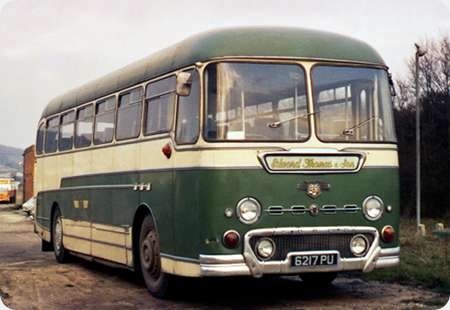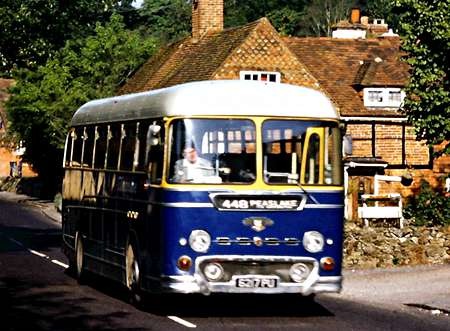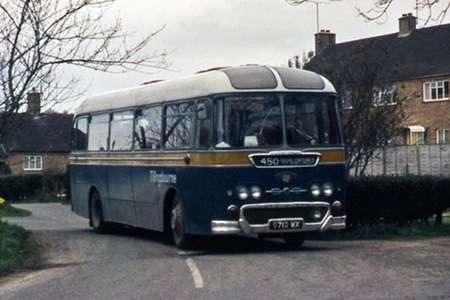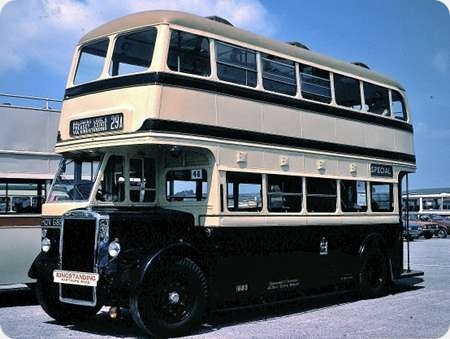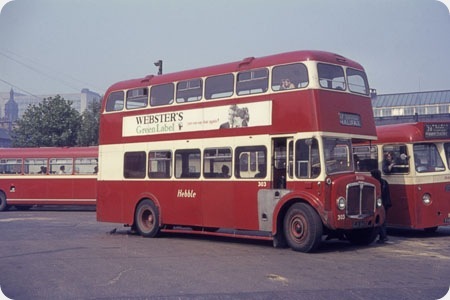
Hebble Motor Services
1957
AEC Regent V D3RV
Weymann H33/28R
Due to a height restriction at their garage in Walnut Street, Halifax, Hebble had always purchased lowbridge double deckers, and their first two Regent V’s (75/76, GCP 4/5) of 1956 carried lowbridge Weymann Orion bodies. However, by early 1957 the northern end of the garage had been modified to accept conventional highbridge buses and so the next double deck deliveries were the first of this layout.
As with the previous pair they were AEC Regent V’s of the D3RV variety, with the A218 9.6-litre engine from the Mk. III and vacuum brakes, but with Weymann Orion H33/28R bodies. On delivery in March 1957 they were the last vehicles to be numbered in the original fleet number series (81-83, GJX 845-847), but by June a new numbering scheme had been introduced and they became 301-303. They were still unable to pass through into the lower section of the garage and after a few incidents it was decided that highbridge vehicles should have their radiator cowls painted in cream, as well as having cream steering wheels as a warning measure. They were half a ton lighter than the two lowbridge Mk. V’s and were consequently very potent performers, producing the most amazing growling sound effects from their straight-through exhaust systems. They also initially had exhaust brakes which added an impressive cacophony of clicking, hissing and booming sounds whenever the brakes were applied, and I’m sure that many Hebble drivers drove them to exploit these effects to the maximum – I know I would have done !
I believe that at first 301 and 302 were initially allocated to Bradford Park Lane garage to operate Hebble’s share of the 64 Bradford-Brighouse-Huddersfield, as I saw them only occasionally in their early days passing our house at Stump Cross, Halifax, but 303 was based at Halifax and quickly became a regular sight on the 7/17 services to Bradford, and was a favourite for operating the very fast-timed Saturdays-only 29 ‘Wibsey Flyer’ to Bradford via Wibsey. After these Hebble switched to forward entrance Mk. V’s and the cream front cowls continued to be applied for a while, but by 1960 they had reverted to red. Originally in red with a single cream band above the lower deck windows, they later had the cream extended around those windows, then following the delivery of their first and only new Fleetline in 1966 cream was also applied around the upper deck windows too, as shown in the photo above. The fleetnames were originally of the block capital style with the middle letters undelined, but later an italic style was adopted.
301 was withdrawn in April 1970, but 302/303 survived a little longer to be renumbered into a Yorkshire Woollen-based series as 600/601, 600 being withdrawn in December 1970, but 601 lasting until the end of Hebble’s stage service operation in March 1971. All passed to the dealer W. North of Sherburn-in-Elmet, but by this time Hebble’s maintenance standards had sunk to an all time low and they found no further buyers other than the scrap man. A sad end to some most impressive buses.
Photograph and Copy contributed by John Stringer
09/06/16 – 16:58
I’ve just realised I made an error in the copy. 81-83 were not numbered in the original series, which had commenced at 1 in 1924 and reached 190 by 1947, whereupon a second series reverted to 1 again and reached 83 with these Mk. V’s. (Eight second hand Tiger TS7’s and TS8’s from Yorkshire Woollen District were tagged onto the original series as 191-198, presumably as they were not intended to stay long).
John Stringer
09/06/16 – 19:09
Hebble was a bit of an anomaly in that although a BET operation it was much smaller than the municipal operators with which it co-existed. Halifax, Huddersfield, Bradford and Leeds were all much larger and shall we say more prestigious operations than Hebble. Probably not surprising that in the end it was swallowed up by Halifax although some of the coaching operations went to Yorkshire Woolen if I remember rightly.
Philip Halstead
10/06/16 – 05:39
I have long wondered why the National Bus Company subsequently allowed the engineering standards at Hebble to degenerate to a point where the vehicles were operating in a state that bordered on, or in some cases, actually attained, the dangerously illegal. GGH refers to some truly hair raising (though, sadly, not for me, nowadays) examples of Hebble maintenance, or the lack of it, that emerged on HPTD taking over the company in 1971. From 1968, NBC inherited the nationalised element of the Halifax Joint Omnibus Committee, plus the entire Transport Holding Company and BET interests in Hebble. Why then did it wait three years during which time Hebble suffered inexcusable neglect before offering the business to Halifax? Were there some political sensitivities to smooth over, such as the possible wounds to civic pride in Leeds and Bradford, that might have arisen with the arrival of Halifax operations in those cities? I am sure that John’s remarkable understanding of the wider scene will furnish some answers.
Roger Cox
12/06/16 – 06:51
Before the takeover by Halifax in 1971, some Hebble routes based on Bradford had been transferred to West Yorkshire Road Car (WYRCC), including the Bradford – Huddersfield service 64.
In 1972, Calderdale JOC (the undertaking formed by the merger of Halifax and Todmorden JOCs) transferred one bus working on the former Hebble Bradford – Brighouse route to WYRCC. At the same time, to replace the loss-making ex-Hebble Halifax – Bingley service, WYRCC reorganised its own services in the area. These changes were partly a response to NBC’s claim that Halifax had taken over so much of Hebble. The JOC’s report had even envisaged the possibility of WYRCC participating in the former Hebble Halifax – Leeds service, but this did not happen.
Geoff Kerr
12/06/16 – 06:52
In terms of injured pride in Leeds and Bradford. Bradford used to have joint services with Hebble while the services to Leeds had limited pick up and set down rules. When Calderdale took over the rules continued so there was no loss of traffic but Leeds.
Chris Hough
12/06/16 – 09:08
If I remember rightly – its a long time ago but maybe mid 1970s – the Leeds – Dudley Hill – Halifax service, formerly 8 but later 508, became operated by Leeds’ Bramley depot. So parochial had LCT’s western operations been up to then (apart from the 72 joint with Bradford CT) that those venturing to Halifax were looked on with the reverence usually reserved for spacemen and the like!! Chris H may have more accurate information??
Chris Youhill
12/06/16 – 16:56
Roger, I’m afraid my ‘understanding of the wider scene’ does not extend quite as far as you may imagine ! Call me shallow and a bit of a philistine but I have never found the inclination to be that interested in the political machinations that take place both within the industry and between it and national and local government. I tend to be more grounded in the ‘what actually happens on a day-to-day basis’ and ‘how it happens’, than the ‘what ought to happen’ and ‘why it happened’. It’s probably for that reason that it was fortunate that I never progressed into a management career, as I would most likely have become quickly disillusioned and depressed ! Therefore I cannot really offer much in the way of an explanation as to why the NBC took so long to part with Hebble.
Through most of its existence Hebble had directors who were also on the board of Yorkshire Woollen, and the two worked closely together – particularly with regard to coaching, and occasionally lending one another staff. In the last year or two of Hebble’s existence the NBC brought them closer together, the vehicles adopting YWD’s red livery and the vehicles being renumbered in a 5xx/6xx series within the YWD numbering scheme. There was a certain exchange of services, with Hebble’s share of the 64 Bradford-Huddersfield passing to West Yorkshire, and I imagine that all this was seen as the precursor to an eventual absorption of Hebble into YWD, in the same way as Mexborough & Swinton was absorbed by Yorkshire Traction, and Stratford Blue by Midland Red. However YWD themselves were seriously struggling in the late 1960’s with vehicle maintenance and the ability to operate a full service and so they had more pressing matters to concentrate on.
The BET group had always retained those smaller companies mentioned, apparently to provide a means of allowing up and coming trainee managers to hone their skills with a smaller unit before progressing to greater things. Hebble was ideal for this purpose as it operated local stage, express, excursion and tour services, and several well known (in their day) managers of larger BET/NBC companies had at some point done their stint with Hebble. I always felt sorry for Hebble’s last manager – David Dickinson – who suddenly found himself dumped at Halifax with the unenviable, nay impossible task of managing a company that must have seemed to be gasping its last breath before drowning in a quagmire.
There had been occasional talk in the local press since the late 1960’s of the possibility of a takeover by Halifax JOC of Hebble services, mostly put about by Halifax GM Geoffrey Hilditch himself. Some of his newer buses even had ‘Bradford’,’Wakefield’ and other destination included on their blinds, but I suspect that other parties to a possible deal may have regarded Hilditch as a bit of a ‘cocky and ambitious upstart’ and did not want to see him getting his own way and ruling the roost. I may be wrong about that, but I did work under him and know what he was like.
Regarding Chris Y’s comments about the 508 Halifax-Dudley Hill-Leeds (let’s quote it the right way round, Chris !). Leeds’ Bramley Depot came onto the route when it was extended across Leeds City Centre from King Street to the Central Bus Station. They provided two buses, with Calderdale (Halifax) providing the other three. Bramley drivers quickly developed an appalling reputation for running early, especially in the evenings, and having a generally bad attitude. I worked permanent late duties on the 508 for a few years during this period and regularly observed them passing in the opposite direction up to 20 minutes early on many occasions, and probably hundreds of people were left behind over the years – most never having even seen the bus go by and having just assumed it had been cancelled.
When it was decided (rather foolishly, as it turned out) to extend the 508 beyond Halifax westwards out to Rishworth, for the unadventurous Bramley drivers it was the last straw and they would have none of it, so Calderdale drivers got the whole service back to themselves again. The Rishworth extension was not a success and it was soon cut back to its original form, but Leeds were never invited back on again and to this day, though now operating into Leeds via Farsley and Kirkstall, it is still 100% First Halifax worked.
John Stringer
13/06/16 – 05:56
John, You didn’t miss out much by forgoing a management ‘career’. Much of mine was spent with LCBS, its forebears- not too bad generally, but its successors became an entirely different story. With the fracturing of the established companies in preparation for privatisation, things became very nasty at times as certain people used every stratagem available to secure their futures under the new order. I was glad to get out of Kentish Bus at the end of 1987, and resolved never again to seek a bus industry management post in the cut-throat private ownership environment.
Back to Halifax. Yes, I too can well appreciate the existence of a level of scepticism at NBC about Geoffrey Hilditch, who never disguised his "Greater Halifax" aspirations. This might have influenced NBC to hang on to the rump of Hebble until its survival became perilous, but the neglect of the company was utterly disgraceful. Independent operators would have had their operating licences revoked if engineering maintenance had declined to the dangerous state that existed with Hebble. Turning to the unreliable Leeds element in the joint operations with Calderdale, this does illustrate a weakness that often arises in supervision standards when two different participants are involved in a route. Did the Calderdale inspectorate not have authority over the Leeds staff on the joint operation?
Roger Cox
13/06/16 – 05:58
Thanks John for a wealth of interesting information about the 8/508 service, and by way of humble excuse I must admit that I was reading my compass wrong way round when I described the terminal points in the order that I did. As regards early running I sadly have to say that in LCT/Leeds Metro District days this crime was by no means confined to Bramley depot – the same was widespread at Seacroft, Middleton, Sovereign Street, Headingley and Torre Road as well. This meant that the conscientious folks were doing all the work while the work shy element had an easy time, and of course the passengers suffered as a result. To a very large extent the satellite tracking system of modern times has virtually eliminated early running and a good thing too.
Chris Youhill
13/06/16 – 10:59
Roger – your last sentence raises a most interesting point regarding joint operation of a service. The old established 72 service from Leeds to Bradford was shared by Leeds City Transport and Bradford City Transport and the inspectors of either could supervise any bus and it worked very well indeed. As an enthusiast I quite often, if on the area, took advantage of this to check superb Bradford buses. The silent recommendation though was that the inspectors of each operator would more or less stay local normally. I recall one occasion when I slipped up badly – I boarded a "Bradford blue" on the Leeds Ring Road at Wortley and on the front seat upstairs was an obnoxious character claiming that he couldn’t find his ticket. I "smelt a rat" and insisted that he did and in turning out each pocket, deliberately slowly, he produced an astonishing array of old rubbish and battered tickets galore – but no valid one. A further rumpus occurred as he finally realised he was going to have to pay again and by the time I’d seen to that – I’d been totally engrossed in the case – I realised to my horror that the bus was at Laisterdike within a mile or so of Bradford. I should add that checking the Bradford tickets was a bit of a nightmare anyway as they were still using low value Ultimate tickets even on such long routes. Now the Leeds Chief Inspector of the times was an unreasonable tyrant and used to forensically examine our checking sheets in the hope of finding something to "nit pick" about, but mercifully my delightful "away day" trip went un-noticed for a change."
Chris Youhill
13/06/16 – 17:14
Halifax inspectors certainly had authority over Leeds drivers within Calderdale, and similarly Leeds inspectors could – and regularly did – check Halifax buses in Leeds. The middle section of the 508 route also passed through a significant sector of Bradford too, but I don’t ever recall their inspectors ever boarding. The problem in the evenings was that there was only one inspector allocated to ticket checking duties, and even then they would always use the flimsiest excuse to seize the opportunity to avoid going out ‘on the road’ if there was a nice little warm office job that could be found. Even then, if they did go out the service had been reduced so much that it was no longer possible to just hop on and off buses at random, and most had a set sequence of bus journeys and connections worked out that was the same every day. Consequently all the drivers knew what trips they would board, and more importantly which they wouldn’t. One particular inspector had his checking sheet written up in advance and would spend a considerable time in the late afternoon going through the sheets to ascertain which drivers would be on which trips. Then over teatime he would sidle into the staff canteen and seek out these various drivers, sit down alongside them and start up a friendly conversation. Then he would quietly ask them to verify they were on a particular trip on his sheet, then slip it beside their their dinner plate, point to the appropriate line and say "Just sign there – save me a job". All being well he would gather signatures for every journey, then of course not bother leaving the office all night ! Either that, or he would slope off home for a few hours. We shouldn’t have signed of course, but then they always had ways of getting their own back if you refused.
I have to confess a bit of inexcusable naughtiness on my part. There was one particular inspector who did go out checking and always started out boarding my regular first trip after tea – the 1850 508 Leeds. He would ride to the lower reaches of Northowram where he knew he could then cross the road and catch the inbound 508 back to Stump Cross, then on to a 549 Brighouse and so on. My trip was always lightly loaded out of town, but this chap was a bit of a chatterbox and would stand at the front yacking on about this and that. I would deliberately drag my heels up the road and divert his attention from checking his watch and looking out for the inbound bus. Nine times out of ten I would be able to manipulate matters so that he missed his connection and he would then have to get off and wait ages for the next one – his evening’s entire plan totally fouled up ! Yet he always fell for it.
As far as checking Leeds Bramley drivers running early, Halifax inspectors’ prearranged plan did not include their trips as they didn’t ‘fit’. Though the first time point at Shelf was within Calderdale, the ones at Odsal, Dudley Hill and Stanningley Bottom were in Bradford (where nobody wanted to check) and the one at Bramley Town End was in Leeds. The worst trips for running early were their last two from Halifax at 2220 and 2250, after which they ran to Bramley Depot – in fact the last one terminated at Bramley Town End and ran straight in from there.
During the daytime on the 508 it was laughable the way that once past Stanningley Bottom going towards Leeds, the Leeds drivers upon spotting a 508 catching them up would slow right down to a crawl and then pull in at the next stop, irrespective of whether there was anyone boarding or alighting. They would then remain there until the Halifax driver passed them. If I had to pull in myself to drop off, and stopped behind the Leeds bus, they would still not move off, and if necessary would just pull forward a few feet, then wave me past. They used to do it to one another too, and it was not unusual to see maybe three assorted Leeds buses parked up waiting for each other to move, or just crawling along at 5mph in a convoy – all waiting for a 508 to pass them and clear the road. Halifax drivers were different altogether and couldn’t be bothered with all this dawdling and work avoidance, so we just used to whizz past and get on with it.
John Stringer
14/06/16 – 06:04
What fascinating and slightly worrying information, Chris and John. If timetables were so blatantly disregarded and bunching so common, is it any wonder that many bus users said "enough’s enough" and bought a car? It would be understandable if traffic was the cause of bad timekeeping, but such "Spanish practices" (if I’m allowed to say this phrase nowadays) showed a disdain for the passengers. You and Chris were obviously true busmen, but some of your colleagues did a huge disservice to the industry and certainly helped to perpetuate the downward spiral of bus use.
Paul Haywood
14/06/16 – 06:05
Gosh John, now there really are some revelations there and its safe to say that with the Chief Inspector at Leeds, the tyrant I mentioned – others in the post were fair but stern, the Halifax inspectors would never have got away any of that Luddite activity and forgery. On another point, perhaps the Bradford inspectors were only permitted to board Leeds CT/Metro buses on the two joint services 72 and 78??
Chris Youhill
14/06/16 – 06:05
Sorry to nitpick John but Stanningley Bottom was and is well within the city boundary of Leeds and their inspectors should have been actively checking tickets and time keeping.
Chris Hough
14/06/16 – 11:14
Chris H – you are correct regarding the current Leeds boundary but psychologically Stanningley Bottom was, since tramway days, always considered to be the boundary between Leeds and Bradford.
To be pedantic, the correct name is Stanningley Bottoms. I first heard this used when I travelled from Leeds to Stanningley on a Hebble Regal 3 saloon. Thinking I had boarded the wrong bus, the conductor announced "First stop Stanningley Bottoms!" which, for a ten-year old, I found highly amusing. I hadn’t boarded incorrectly, of course, as I wanted to experience the thrill of riding non-stop all the way up Stanningley Road even though this involved a lengthy walk home.
Those old fare protection arrangements limited the choices for some, but gave a much speedier ride for many others travelling further distances. This advantage is now largely lost as most interurban services stop at every road end and penetrate every sprawling housing estate regardless of potential usage.
Until 1974, of course, Stanningley was effectively split within Leeds, Pudsey and Farsley which must have been a nightmare for village life. The old boundary with Leeds was a few hundred yards east of the Bottoms (which was part of Pudsey).
Local government reorganisation had many faults but at least it unified this community.
Paul Haywood
15/06/16 – 06:12
One point is that blatant early running must have led to very low passenger loadings, and examination of receipts over time would tend to suggest that particular services, or even whole routes, were surplus to requirements.
Stephen Ford
15/06/16 – 18:16
I spent many years in the bus and coach industry, and have to say that an unholy alliance of obstreperous (and militant) drivers, undisciplined supervisory staff (as set out above) and indifferent and incompetent management are largely responsible for the self-destruction of the bus industry. I have heard many times the comment "This would be a good job if it wasn’t for the passengers" only half tongue in cheek.
It is fashionable to poo-poo the word customers when referring to passengers (and it is true that this is often used insincerely to try to pull the wool over said customers eyes) but I have the notion that if more basic customer care had been used when passengers were there in plenty then perhaps they wouldn’t be so scarce now. It is unfortunate that many in service industries in the UK are unable to distinguish between "service" and "servile".
Malcolm Hirst
16/06/16 – 05:50
Very well summed-up, Malcolm! It reminds me of the attitude in many shops, not very long ago and I am amazed that some of them survive, where staff had the attitude "If we’ve got it, it’s on the shelf. If it isn’t on the shelf, then we haven’t got it." However did the management let the staff get away with it?
Pete Davies
16/06/16 – 08:13
Way back in 1972/3 I applied for a job as a Schedules Clerk with Leeds City Transport. Glad I did not get it.
Stephen Howarth
17/06/16 – 06:12
We shouldn’t forget the Traffic Commissioners, either, acting as arbitrators among competing operators when any changes to routes were applied for by one of them and, seemingly, usually keeping the status quo, with nobody ever considering what would serve the customer better!
Christopher Hebbron
18/06/16 – 06:11
To some extent I agree about the Traffic Commissioners.However on the bus scene some protection was (and is?) desirable to protect the network so as not to concentrate all operators on the same lucrative routes. One of the unfortunate by-products of deregulation was the ending of the often used principle of cross-subsidisation where many operators partially subsidised unremunerative routes to preserve their commercial position. When opened to full competition this became an expensive exercise and so it has led to curtailment of services and ever-more expensive subsidies to keep the minimum of service levels.
It should be noted that the predictions by the pro deregulation brigade of free competition and lower fares/better services have never come to pass – and the alliance of nominally competing groups have a monopoly that NBC could never have dreamed of.
Most of my experience has been in the coach industry and there the Traffic Commissioners activities were really restrictive. There was little or no opportunity to innovate. Objections to linking of licences often meant that some towns and villages had almost no excursion provision, and attempts to serve special events always led to objections by the express operators even where a day return facility did not exist ! Experiments to tap new sources of traffic or innovative destinations were almost impossible.Now that the major operators have mostly opted out of "occasional" coaching the opportunities are theoretically there, but the potential customer base is now so small that it must be difficult. Creating excursion traffic is hard work, and requires real flair and many man-hours. The "regional companies" (NBC parlance) were happy to get the revenue but I think in many cases they saw the work required as a distraction. Early deregulation of the excursion business together with an even earlier ditching of the silly (and unenforceable) separate fares rules would have led to a much healthier outcome.
Malcolm Hirst
